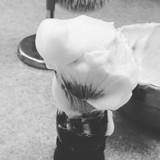Shaving Soap

In today's article we will explore the world of soap and, more specifically, shaving soap. The making of soap dates back thousands of years and is essentially the process of combining animal or vegetable fats or oils with an alkaline solution. A chemical reaction takes place (I won't go into the chemistry, if you are that curious you can Google it), and the end result is soap. A by-product of this process is glycerol (glycerin). The chemical reaction that takes place is called saponification. There are two chemicals used in soap-making, Sodium Hydroxide (NaOH),also known as lye or caustic soda, and Potassium Hydroxide (KOH), also known as caustic potash. Soap made with NaOH is hard while soap made with KOH is soft or liquid.
When making soap it is important to use the correct amount of alkaline solution for the amount of oils, too much will result in soap too high in PH - this is bad and will burn your skin. Too little, and there will be excessive unsaponified oils and will be greasy and won't lather well.
So what makes a shaving soap different from a bath soap or hand soap? In a nutshell, shaving soaps are formulated to produce a dense, slick lather. Bath soaps or hand soaps generally produce big bubbles. However, if you examine the lather of a quality shaving soap, you will notice the lather is very dense with micro-bubbles. Shaving soaps are often made with a small percentage of super-fats (fats or oils added after saponifcation completes) to provide additional slickness.
Here at BTRC we make our premium soap in small batches using a combination NaOH / KOH alkaline solution for a not too hard and not too soft product. We have meticulously selected a blend of high-quality fats and oils that produce a shaving soap with the most desirable properties.
